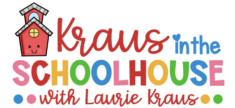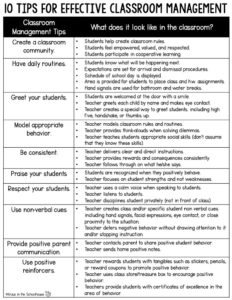Wouldn’t it be nice if all students behaved according to our expectations? Ideally, yes! However, the reality is quite different.
When I take a step back and reflect on best teaching practices, the use of behavior charts is not on my list. Behavior charts advertise students’ daily behavior to the class and any visitors that enter the classroom. It publicly shames students. It labels students. It focuses on the negative. It doesn’t differentiate and sets the same expectations for all students.

When using a behavior management system, it is always important to reflect and see if the purpose of the chosen system is actually successful. We want to ask ourselves:
Is the behavior of my students improving by using this classroom management system?
I am quite certain the answer is going to be NO! In my experience, the students who misbehave have to change their color, move their clip, or follow what the chart entails on a weekly, if not daily, basis.
My own personal experiences have led me to realize that these charts are band-aids that might temporarily stop the undesired behaviors but do not have any long term benefits. During my first few years of teaching, I was using a behavior color pocket chart which required students to switch their colors indicating what consequences they would receive (similar to the behavior management pocket chart below).
It was during that time that one student, in particular, taught me a very valuable lesson. This child entered my classroom already labeled as a huge behavior problem. His previous teacher wished me good luck when she saw his name on my class list. He didn’t disappoint his reputation and was a frequent visitor to the behavior chart. By the end of the school day, he usually received all of the consequences including time out, limited recess, and a phone call home to mom. It had become more of his routine than anything else. One day, he walked into class and refused to begin the morning work. After a gentle reminder and a warning, he was told to change his color card. He slowly walked up to the chart and switched all of the colors and placed himself on red (phone call home). He turned around, looked at me, and simply stated, “I’m done for the day, now what?”
Those seven words changed my entire perspective of behavior charts. From this one student, I realized that this classroom management method was not working. His behavior wasn’t changing. He knew the outcome of his day before it even began. At that moment, I knew I had to reflect on my teaching practices and find a better way to manage the classroom. What did I learn? I found some very valuable ideas and tools and grouped them into Ten Tips for Effective Classroom Management.
1. Create classroom communities. This will provide students with a sense of belonging. Each child feels as if they are a valued member of the classroom and take part in creating the classroom rules. Children work together in cooperative groups and learn how to share ideas and respect each other.
2. Have daily routines. Students thrive on organization and consistency. Students know what to expect from the moment they enter the classroom until dismissal. Children are more relaxed in a structured classroom with set expectations.
3. Greet your students. Waiting at the door to greet your class enables children to begin their day in a positive way. Smile, say their name, and make eye contact. As an added plus, create a special way to greet them. This can include a hand shake, thumbs up, or a high five. So simple, yet so meaningful.
4. Model appropriate behavior. This enables students to learn and understand your expectations. Too often we assume children know proper social skills. It is important to set aside time to teach and model these important skills. Think-alouds are a great way for students to hear how you solve problems that you are faced with.
5. Be consistent with your classroom management. Provide clear and direct instructions to your students. Give rewards and consequences consistently. If you say you are going to do something, then do it! Students can easily become frustrated and misbehave if you are not following through on what you say.
6. Praise your students. Recognize them when they are positively behaving. Some children thrive on attention. What better way to give it to them! Focus on what your students can do. Build their self-esteem by bringing out the best in them.
7. Respect your students. We all want our students to show us respect, it’s just as important that we respect them. Use a calm voice, screaming is not effective and is more about you not being able to handle the situation then about their misbehavior. Listen to your students. Often times we only listen to one side of a story. Make sure all voices are heard. When the need arises to discipline a child, do it privately. Publicly shaming students does not benefit anyone. It belittles the child and provides a show for the other students.
8. Use non-verbal cues. This will help to deter negative behavior. This enables you to continue teaching and not draw attention to the misbehavior. Create class and/or specific student non-verbal cues which can include hand signals, facial expressions, eye contact, or close proximity to the situation. My students in the past have told me when they saw my ‘teacher stare’ they knew it was time to get serious and start working. These solutions are simple and take so much less time than addressing the situation verbally.
9. Provide positive parent communication. Think about when and why you contact parents. Many times it is to share information about a negative behavior being displayed. How many times do you call parents to tell them that their child was caught behaving? This easy communication is so beneficial for both the parents and child. Now the student learns that behaving in class pays off. You can also write positive notes and send them home with the students. I am sure the first thing they will show their parents is the note. Happy Child = Happy Parent = Happy Teacher
10. Use positive reinforcers. Students love to earn tangible items such as stickers, pencils, and reward coupons. These items can be given immediately after the positive behavior has occurred. Treasure boxes and class stores can be used to provide positive reinforcement after a certain amount of time. In my class, we would open the class store every Friday. The students looked forward to shopping and earning their rewards.
The biggest takeaway for me when reflecting on my classroom management was that each school year brought different behavior challenges and it was very important to be flexible in my teaching practices and beliefs. What worked one year, did not always work the next. During my first year of teaching, I struggled greatly with my classroom management. My dad, a retired high school history teacher, always reminded me that tomorrow is a new day. A new day for you to implement effective classroom management strategies so all students can grow and learn in a safe and nurturing environment.
If you are interested in the 10 Tips for Classroom Management along with a free poster and a creating classroom rules activity, click on the resource below.
Check out these other resources that will help you promote a positive classroom community in a structured environment.
So, I must ask… What are your thoughts on behavior charts? Do you have any suggestions to add to the effective classroom management tips? Comment below. Looking forward to hearing from you.








